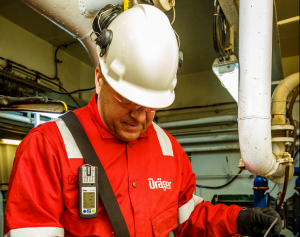New North Sea Safety Contracts Dräger
 Dräger Marine & Offshore will supply equipment which detects and protects workers from hazardous gases to 23 platforms across the North Sea, under three new contracts worth more than EUR 1,100,000.
Dräger Marine & Offshore will supply equipment which detects and protects workers from hazardous gases to 23 platforms across the North Sea, under three new contracts worth more than EUR 1,100,000.
The deals involve provision of portable gas detection equipment to three major operators over five years, including more than 1,700 personal gas monitors designed to warn personnel of potential dangers.
Combustible gases and vapours such as carbon monoxide, hydrocarbons and hydrogen sulphide, which can be fatal in sufficiently high doses are monitored by the company’s X-am 2500 portable gas detectors, which will be deployed on and offshore. Dräger designs and manufactures the sensors, which have a five-year warranty, to lower operational costs without compromise to safety. A testing and calibration station is also supplied which manages maintenance of the equipment, removing the need to return equipment to shore. The Dräger X-dock allows personal gas monitors to be tested in less than fifteen seconds, ensuring they are safe for use.
Lawrie Kerr, Sales Manager of Dräger Marine & Offshore, says, “These contracts demonstrate the value our technologies offer in protecting personnel in oil & gas, as operators continue to invest in safety as one of their top priorities in exploration and production. The depth of expertise and breadth of the equipment portfolio at our Aberdeen base allows us to provide these life-saving technologies at short notice, and in large volumes for rental or sale to the upstream oil & gas, and downstream petrochemical industries.”
Dräger is making a major contribution as companies in oil & gas seek to achieve Vision Zero and Industry 4.0 targets through its world-leading subject matter experts and technical authorities; along with technologies it develops for Smart Plant. It specialises in confined space and industrial maintenance operations, emergency escape and rescue, protection from H2S and carcinogenic substances, and equipment and training for fire and gas detection. Mr Kerr adds, “As new projects get underway, and efforts to maximise recovery from existing assets are developed, we continue to invest in research and development which will deliver further advances in life-saving technology for the industry.”






